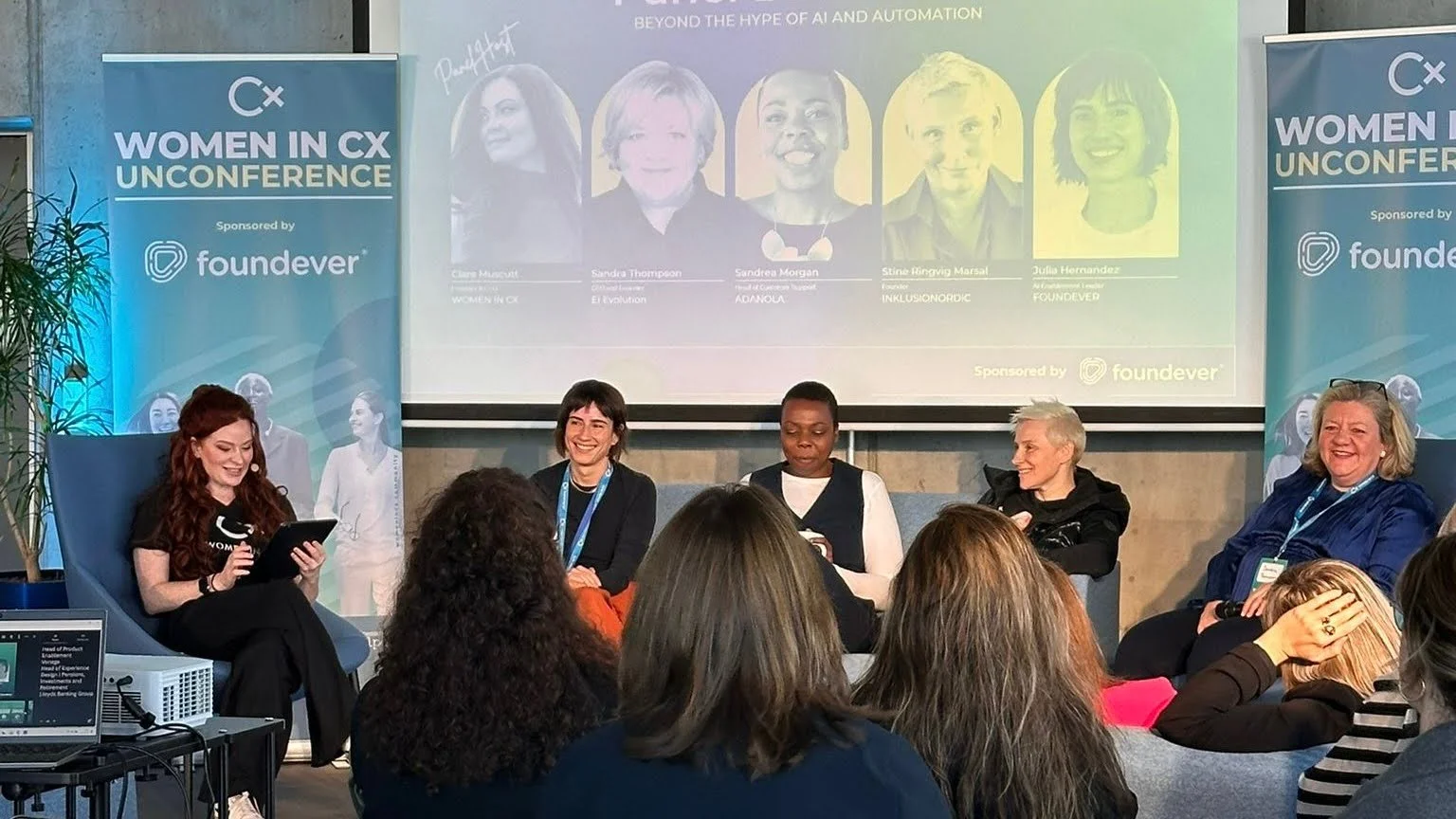What’s Next in CX: Moving Beyond the Hype of AI and Automation
By Clare Muscutt, Founder and CEO of Women in CX
Artificial Intelligence is everywhere in the CX conversation right now. It’s being hailed as the game-changer—bringing faster insights, empowering employees, and promising seamless customer experiences. In fact, 96% of leaders believe AI will unlock efficiency and potential.
But as I heard loud and clear at the Women in CX ‘Moving Beyond’ EMEA UnConference in Berlin, there’s another side to this story. Our panel of conscious leaders took the stage to ask tough questions about hype versus reality and to explore what it will take to build AI that truly serves people.
Because while interactions may be faster, many customers tell us they feel less human, less understood, and less included. And perhaps most worrying of all, the latest CX Landscape report shows 67% of organisations are implementing AI without governance—leaving the door wide open to misinformation, compliance risks, and bias.
So, how do we move beyond the hype and ensure AI is built to serve people—not the other way around? This is what we set out to explore together in Berlin.
That’s why our session went beyond the hype to ask three critical questions:
What’s real versus what’s hype in AI and automation today?
How can we design human-centred, emotionally intelligent customer experiences with technology?
And what role can women in CX play in shaping an inclusive, ethical, people-first future for business?
The Strategic Imperative: Intent Before Tools
The question we began with was simple: what’s most misunderstood about AI in CX right now?
For Sandrea, Head of Customer Support at Adanola, who has just gone live with AI in her organisation, the big misunderstanding is scope. “AI can do so much more than answer simple queries,” she explained. Integrations can be lightning fast—in her case, “a 15-minute phone call” to plug in APIs.
But moving fast without thinking can be risky. Sandra, an Independent Emotional Intelligence Expert, shared the infamous Taco Bell story, where a drive-through Voicebot AI ended in chaos— with one example of bots ordering “18,000 bottles of water.” Due to a lack of guard rails and testing, it was rolled out to over 500 locations and had to be rolled back.
As Stine, an Independent Expert in Inclusion, pointed out, these weren’t tech failures but human ones: “These are horror stories—but what was your testing and assessment process? Because it shouldn’t have happened.”
Julia offered a reminder to resist being dazzled by vendor demos: “Always focus on the problem, not on the tool.” If it’s not solving a real pain point or empowering employees, it’s not value—it’s hype.
✨ Takeaway: The real failures of AI aren’t technological—they’re human. Without rigorous testing and governance, even the smartest tools can create chaos.
✨ Takeaway: AI adoption should start with the customer problem, not the shiny solution.
The Ethical Imperative: Designing for the Margins
AI learns from the data we give it. If our data reflects bias, exclusion, or narrow perspectives, that’s exactly what will scale.
Stine made the point powerfully: “One in four has a hidden disability. That’s not a niche—it’s a huge customer segment.” Her philosophy? Design for those at the margins, and you make things better for everyone.
This means opening more channels, not just optimising for efficiency. For example, customers with performance anxiety may prefer a bot to a human interaction. Accessibility isn’t an afterthought; it’s a growth opportunity.
Sandra shared how she influenced tone in ChatGPT by literally defining “empathy” in her prompts, while Julia described correcting gender bias in machine translations. Leaders can and should teach AI the values they want it to reflect.
✨ Takeaway: Inclusion isn’t optional. Building human-centred AI starts with designing for those who face the biggest barriers.
The Emotional Imperative: Keeping Humanity at the Heart
If there’s one thing AI cannot replicate, it’s human value. But that doesn’t mean employees won’t feel threatened as automation grows. Sandra warned that ignoring the emotional side of this shift can create “carnage”—people feeling “useless, out of control, and in despair.”
Sandrea’s own rollout offers a blueprint for balance:
Prioritise tone – She chose a bot with an “insanely human” voice. Accuracy alone wasn’t enough.
Involve employees – Advisors helped design flows and fix errors, fostering ownership.
Redefine roles – With 70% of queries deflected, her team now focuses on empathetic, complex conversations—and even contributes to marketing and product.
Celebrate human value – She runs sessions helping advisors uncover their unique strengths: enthusiasm, process obsession, fraud detection. “These are the gifts bots can’t replicate,” Sandra added.
✨ Takeaway: Automation should elevate human capability, not erase it.
Women in CX: Leading the Conscious Shift
Finally, we asked: what role can women in CX play in reshaping AI?
Julia didn’t hesitate: “We need to own it, we need to use it, we need to dominate, and we need to have a voice—because if not, AI will replicate the same problems we already see in the world.”
Stine reminded us that the same CX principle still applies: center the customer. Sandrea advised starting with clear use cases. And Sandra gave us a final, grounding word: “Pause. Make conscious decisions, grounded in self-awareness and empathy.”
Final Thought
The Women in CX panel in Berlin made one thing clear: the future of CX will be shaped not by AI alone, but by the leaders who decide how to use it. By centring inclusion, designing consciously, and celebrating the human value in our teams, we can ensure technology truly serves people.
But there’s something even more important here. Research shows that women leaders consistently bring higher levels of empathy, ethics, and collaboration to the table—the very qualities most urgently needed in the governance of AI. As Julia reminded us: “We need to own it, we need to use it, we need to influence, and we need to have a voice—because if not, AI will replicate the same problems we already see in the world.”
This is the moment for women in CX to step forward and shape the narrative. Conscious leadership is not just about adopting technology wisely—it’s about bringing distinctly human strengths into the heart of innovation.
AI is here to stay. But whether it accelerates inequity or enables empathy will depend on us. The future of CX demands that women in CX lead consciously, boldly, and together.
Ready to Move Beyond? Join Us at the Next WiCX UnConferences
The conversation doesn’t stop in Berlin. We’re taking the energy and momentum to the US and LATAM Women in CX UnConference in Miami later this year—where we’ll continue to explore how women can lead the future of CX with empathy, innovation, and conscious leadership.
And we’re already looking ahead to 2026, with registrations now open for the WiCX EMEA UnConference. Don’t miss your chance to be part of the only global CX event created by women, for women—where the agenda is built by you.

